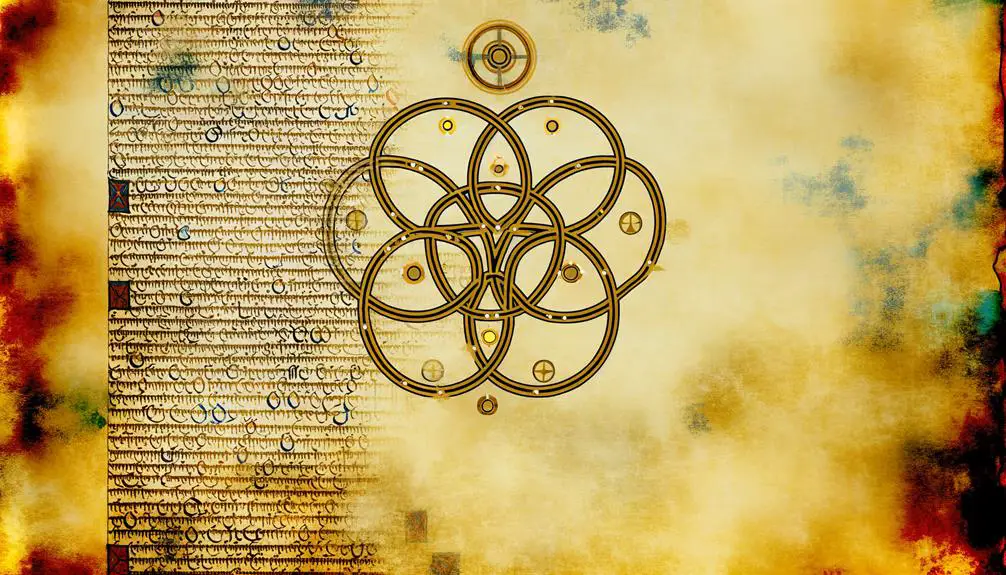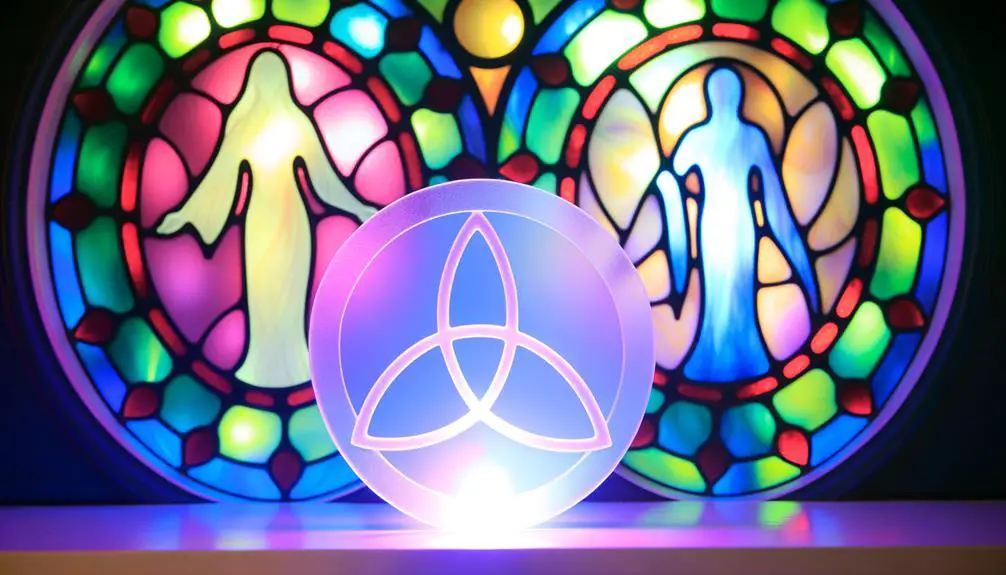Meaning of the Trinity Symbol in Christianity
The Trinity symbol in Christianity encapsulates the profound theological doctrine of one God in three distinct, co-equal, and co-eternal persons: the Father, the Son, and the Holy Spirit (Matthew 28:19). This symbol reflects early Church formulations, especially through the works of Tertullian and the Nicene Creed, asserting the consubstantiality and relational unity within the Godhead.
Augustine's analogy likens the Trinity to a lover, the beloved, and the love shared, illustrating its complex relational dynamics. Understanding this symbol illuminates the core principles of Christian faith and theological thought.
Exploring further unravels richer insights into its historical and spiritual significance.

Key Takeaways
- The Trinity symbol represents the unity and co-eternal nature of the Father, Son, and Holy Spirit.
- It underscores the distinct yet harmonious coexistence of three divine persons within one Godhead.
- The Trinity emphasizes the relational dynamics and interconnectedness within the divine essence.
- It serves as a model for community, reflecting unity within diversity.
- The Trinity transcends human understanding, symbolizing the profound mystery of God's nature.
Historical Origins

The concept of the Trinity in Christianity has its historical origins deeply rooted in early Christian theological debates and scriptural interpretations. Trinitarian doctrine emerged from efforts to reconcile monotheism with the divinity of Jesus Christ and the Holy Spirit, as depicted in various New Testament passages such as Matthew 28:19 and John 1:1-14.
Early Church Fathers, including Tertullian and Athanasius, significantly contributed to this development through their writings and participation in critical ecumenical councils like Nicaea (325 AD). These councils sought to address heresies and define orthodoxy, culminating in the Nicene Creed, which articulated the co-equal and co-eternal nature of the Father, Son, and Holy Spirit. This doctrinal formulation laid the foundational framework for understanding the Trinity.
Theological Significance
The theological significance of the Trinity symbol is profound, encapsulating the unity of divine persons—Father, Son, and Holy Spirit—while maintaining their distinct identities.
This mystery of three-in-one is grounded in scriptural references such as Matthew 28:19 and 2 Corinthians 13:14, which highlight the co-equal and co-eternal nature of the Godhead.
An analytical approach reveals that this doctrine not only underpins the Christian understanding of God's nature but also informs the relational dynamics within the divine essence.
Unity of Divine Persons
In Christian theology, the concept of the Trinity underscores the unity of the Father, Son, and Holy Spirit as three distinct persons sharing one divine essence, as illuminated in John 10:30. This passage, "I and the Father are one," reveals the intricate relationship within the Godhead, emphasizing both unity and distinction.
The Nicene Creed further reflects this unity, asserting the consubstantiality (homoousios) of the three persons. Theologically, this unity demonstrates perfect harmony and mutual indwelling (perichoresis), where each person fully participates in the divine nature without merging into a single entity.
Scripture, such as Matthew 28:19, commands baptism in their united name, reinforcing the indivisibility and coequality of the Trinity's persons while maintaining distinct roles.
Mystery of Three-in-One
Exploring the theological significance of the Trinity's mystery reveals a complex yet coherent doctrine that challenges human understanding while profoundly shaping Christian belief and practice.
Central to this doctrine is the concept of perichoresis, describing the interpenetration and mutual indwelling of the Father, Son, and Holy Spirit (John 14:10-11).
The Nicene Creed affirms this unity, stating that the three persons are 'consubstantial' or of the same essence.
Augustine's analogy of the lover, the beloved, and the love itself further elucidates this relationship.
This mystery underscores the relational nature of God, offering a model for human relationships grounded in love and unity.
Therefore, the Trinity remains a cornerstone of Christian theology, inviting contemplative reflection and deeper understanding.
Symbolic Interpretations

Under the domain of symbolic interpretations, the concept of the Trinity in Christianity can be examined through the lens of Unity in Diversity and Divine Relationship Dynamics.
Scripture, such as John 17:21, highlights the harmonious coexistence of the Father, Son, and Holy Spirit, epitomizing unity despite distinct personhoods.
Analyzing these dimensions not only underscores the theological profundity but also illuminates the intricate relational dynamics within the Godhead.
Unity in Diversity
The symbol of the Trinity in Christianity encapsulates the profound theological concept of unity within diversity. It is evidenced through its representation of the Father, Son, and Holy Spirit as three distinct yet coequal and coeternal persons of one divine essence.
This theological construct is rooted in scriptural references such as Matthew 28:19, where believers are baptized "in the name of the Father and of the Son and of the Holy Spirit."
The unity within diversity evident in the Trinity underscores a harmonious coexistence that transcends individual distinctions without diminishing the essence of each person. This concept serves to illustrate the elegance of divine complexity and mutual interdependence, fostering a deeper understanding of the nature of God in Christian theology.
Divine Relationship Dynamics
Building on the concept of unity within diversity, the symbolic interpretations of the Trinity further illuminate the intricate dynamics of the divine relationship among the Father, Son, and Holy Spirit.
These dynamics are often explored through scriptural exegesis, such as John 1:1, where the Word (Logos) is both with God and is God, highlighting the Son's consubstantial nature with the Father.
Additionally, passages like John 15:26 describe the Holy Spirit proceeding from the Father and testifying of the Son, emphasizing interdependence and mutual glorification.
Theologically, this perichoresis—mutual indwelling—demonstrates a perfect communion devoid of hierarchy but rich in relational depth, revealing a divine model of love and cooperation that transcends human understanding.
Biblical References
Biblical evidence for the concept of the Trinity emerges from various passages in both the Old and New Scriptures, reflecting a complex and multi-faceted understanding of God's nature.
In Genesis 1:26, the plural pronoun 'Let us make man in our image' hints at a divine plurality. The New Writ further elucidates this notion; Matthew 28:19 commands baptizing 'in the name of the Father, and of the Son, and of the Holy Spirit,' presenting a triune formula.
Additionally, 2 Corinthians 13:14 offers a benediction invoking the grace of Jesus, the love of God, and the fellowship of the Holy Spirit. These passages collectively underscore a theological framework supportive of Trinitarian doctrine, affirming a unified yet distinctly triadic deity.
Artistic Representations

Beyond textual evidence, the concept of the Trinity finds profound expression through various artistic representations that have shaped Christian iconography and theological understanding throughout history. Iconic depictions, such as Andrei Rublev's 'The Trinity' (c. 1411), utilize visual symbolism to convey the co-equal and co-eternal nature of the Father, Son, and Holy Spirit.
The use of interlocking rings or the Triquetra, often seen in illuminated manuscripts and ecclesiastical art, symbolizes the unity and indivisibility of the three divine persons. Such representations not only elucidate scriptural references like Matthew 28:19, but also offer a tangible medium through which believers can contemplate the mystery of the Trinity.
These artistic endeavors underscore the integral role of visual culture in articulating complex theological concepts.
Influence on Worship
The doctrine of the Trinity profoundly shapes Christian worship practices, infusing liturgical elements with theological significance that reflects the triune nature of God.
Central to this is the Trinitarian formula found in Matthew 28:19, where believers are baptized 'in the name of the Father, and of the Son, and of the Holy Spirit.' This invocation permeates liturgies, prayers, and sacraments, exemplifying the unity and co-equality of the Godhead.
The Nicene Creed, recited in many denominations, emphasizes Trinitarian belief, reinforcing doctrinal truths during communal worship.
Hymns and doxologies frequently extol the Trinity, such as the 'Gloria Patri,' underscoring the theological premise that worshiping one aspect of the Trinity inherently involves veneration of all three Persons.
Modern Perspectives

In contemporary theological discourse, the doctrine of the Trinity continues to evoke diverse interpretations and applications, reflecting both continuity and innovation in understanding this foundational Christian belief.
Modern theologians often engage with historical exegesis and scriptural texts, such as Matthew 28:19 and John 1:1, to explore new dimensions of Trinitarian theology.
Some scholars emphasize relational aspects, viewing the Trinity as a model for community and social ethics. Others focus on interfaith dialogue, seeking common ground with non-Christian traditions.
This evolving perspective underscores the Trinity not merely as a doctrinal assertion but as a dynamic symbol of divine mystery, relationality, and unity in diversity, thereby enriching contemporary Christian thought and practice.
Conclusion
The Trinity symbol in Christianity serves as a prism, refracting the complex theological, historical, and artistic dimensions into a cohesive doctrine of faith.
Its origins, rooted in early Christian thought, and its diverse interpretations, from scriptural allusions to artistic depictions, underscore its profound impact on worship and belief systems.
This symbol, enduring through centuries, encapsulates the intricate interplay between divine mystery and human understanding, continuing to inspire theological reflection and devotion in contemporary Christian practice.






